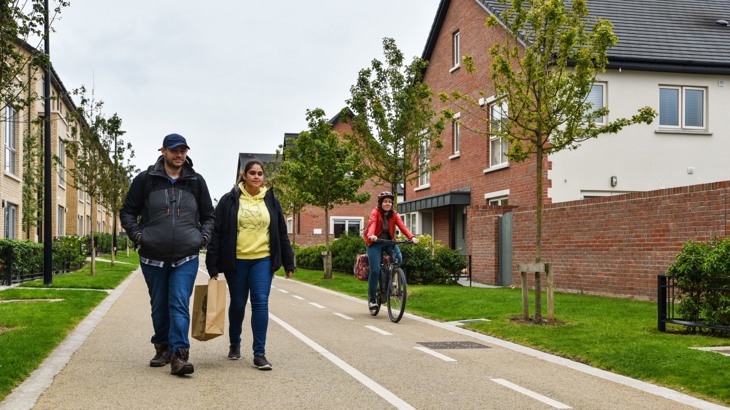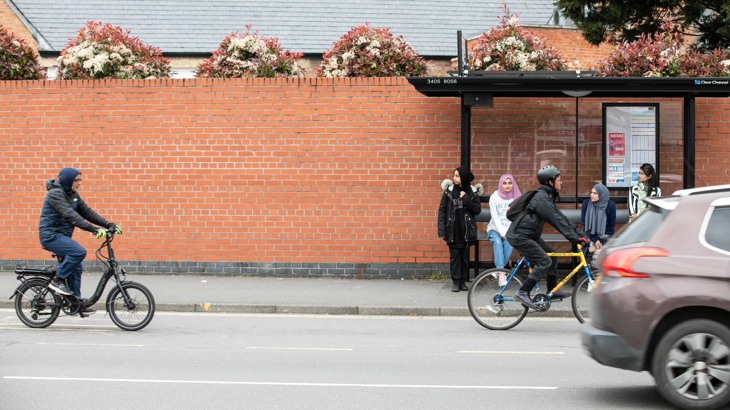The new Government has just set out their plans to build more homes. Dan Simpson, our Senior Policy and Parliamentary Officer, explains that these can be a win-win. We can unlock new housing by creating communities where it’s easy for people to walk, wheel and cycle more of their journeys.

Considering active travel options should be an essential step in planning new developments. Photo: Kieran Ryan
Imagine you’re planning a new development. You need to plan how people get around.
So, you do it how it’s always been done before. You assume that new residents will drive for most journeys.
And when people do move in, your predictions become self-fulfilling.
The big roads you built are harder to cross, so people don’t walk much.
You assumed most people will have a car, so you made the bus infrequent, which makes it a last resort.
You thought no-one would cycle, so you didn’t build safe routes, which means no-one cycles.
We need a new approach if we’re going to build more homes
I’ve sketched out an imaginary development above, but it’s more likely that it simply doesn’t get built.
If we’re going to build the homes we need, we can’t go on with the group think that’s blocked building.
Increasingly, planners and developers are adopting “vision-led planning”.
This means starting from your vision for what you want from the new neighbourhood and building transport infrastructure to make that possible.
You want to give people more choice about how they get around, so you provide them with the infrastructure they need to travel.
You make it easy for them to walk, wheel or cycle for their everyday needs. You give them public transport options.
And, yes, you will still need roads. Probably not as many, though, because you’ve given people other options.
You save land that can be used for more homes. You save money: even relatively short sections of new roads cost millions of pounds.
And you save time: rather than wasting years on building large roads, you can start with quicker things like paths and get on with building homes instead.
We need this to happen everywhere
Earlier this year, we released a report with Create Streets which showed the benefits of applying vision-led planning by default.
We argued that it needed incorporating in the National Planning Policy Framework (NPPF). This sets out how English councils should make decisions on whether to grant planning permission and how they set plans for their areas.
The Government has just released a new draft NPPF, and we’re thrilled that they’ve taken up our suggestion.
This will unlock sites for new housing. At the same time, it’ll help people walk, wheel, cycle and take public transport for more trips.
We need more detail added to guidance to make it clear how to set this vision well, but this is a great start.

The planning of transport infrastructure should be led by the needs of communities. Photo: Kois Miah
It’s about more than cycle tracks and bus stops
One of the key ways that we can help people to use active travel is to make sure that the things people need on a daily basis – schools, shops, GPs and libraries – are close by.
If you have to hop in the car just to buy a loaf of bread, you’re not going to have many opportunities to walk or cycle.
We need to build near existing services or provide new ones from the get-go.
The Government has recognised this in their new draft.
They’ve explained that a location being sustainable with respect to transport is the bare minimum for new housing to be built.
In their “golden rules” for building in the Green Belt, they’ve gone further.
They’ve said that these places should be “connected places”, including delivering new public services and transport links, and green space within walking distance.
It’s great that they’ve recognised the importance of this. There’s no reason, however, why this shouldn’t apply to all significant developments, not just in the Green Belt.
After all, it will unlock new housing by encouraging developers and councils to work together to identify appropriate sites, connect them up to existing communities and provide any new infrastructure necessary.
The planning system can help build a fairer Britain
As well as building new housing, these changes can help us all live well for longer.
This is a focus in the consultation, with the Government asking what more they could do to use the planning system to reduce health inequalities.
This is really important. Where you live shouldn’t determine how long you live, but it does.
Where I live, the life expectancy is 81. As a rule, people here live nine years less than if they lived a few miles away in Kensington.
A lot of this is about our environment: the buildings, roads and open spaces around us.
Councils should make plans and decisions which prioritise tackling these burning injustices.
Acknowledging this in planning policy is something we’ve pushed on for a number of years.
Last year, we put forward an amendment to a Bill in the House of Lords, so it’s good that the Government is looking into it.
At a minimum, the existing requirements to consider health should also refer to inequalities, so that we’re targeting our efforts at those who most need it.
These changes are a welcome start
While these changes are important to see, we can do more, with clear guidance on how these rules should be interpreted.
We’re also going to need to make sure that councils and developers do their bit to make this work, because this is really important.
It’ll help us tackle the housing crisis, and it could help us live healthier, happier lives.
At Sustrans, we're ready to play our part, share our expertise and use good spatial planning to unblock the barriers to building the housing we need.
Want to help make this happen? Respond to the consultation on the National Planning Policy Framework and have your say on how things can be improved.
Get in touch with our Senior Policy and Parliamentary Officer, Dan, to find out the suggestions we'll be making in this consultation.





